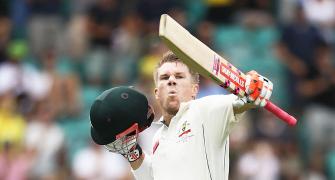'Many of the players in IPL are the sons of men and women who are in ordinary jobs and not well off.'
'These players are the first in their family ever to move into another social class.'
'I think it is a very fine thing that young men from ordinary backgrounds get exposed to fame and money, and playing with legends from abroad and India,' says Aakar Patel.

The Indian Premier League is back for its tenth season, and apparently getting higher viewership than before.
I have always had mixed feelings for it. It was slickly run, but it was thoroughly compromised by the BCCI to the point when it lost credibility.
The courts have interfered to clean up what was essentially a very corrupt and nepotistic system.
One may argue that courts intervene too much in India, and this is true. But this intervention may have restored credibility to the IPL.
This is great because the IPL gives many young players opportunities to make money and display their talent.
This was not the case a decade ago, when there was no IPL.
Having eight teams each restricted to four foreign players in the playing 11 means that there are at least 56 Indians who get a change to show their ability in each match.
This sort of opportunity was not available to young Indian cricketers before. There were and are local teams that compete for tournaments like the Ranji Trophy, but you could not become famous playing these unless you later went on to represent India in the national side.
It is true that as India has become the global economic hub of cricket, and its financial powerhouse, the money given to players in local tournaments has also improved.
But for a long time this money lagged behind what was given to county cricketers in England, who play in 18 teams. The money in England was much better than that in India in those years.
We know that because the last generation of Indian players (like Rahul Dravid for Kent, Sourav Ganguly for Glamorgan and Sachin Tendulkar for Yorkshire) all did stints in county cricket.
These days that does not happen because India has moved ahead and rewards its players better than any team in the world.
Virat Kohli, for example, has never played county cricket and if offered a stint there he would probably not take it because more money is to be made here.
For the players in many other countries, the IPL has become the place to make real money. I remember a story about the great Sanath Jayasuriya. He transformed the way one day cricket was played two decades ago along with his opening partner Romesh Kaluwitharana.
The Lankans developed an explosive style taking advantage of the field restrictions, and helped their country win the 1996 World Cup. As the team progressed through the tournament their government kept promising the players more money.
At one point Jayasuriya said he needed another Rs 1.75 lakh to complete constructing his house.
Sunil Gavaskar writes in his autobiography his father used to give him Rs 10 each time he scored a century in first class cricket and one month he scored so many that it broke the household budget.
It is remarkable to think of such modest sums today when cricketers are paid crores for a few weeks' work and many Indians make over Rs 100 crore a year. I do not grudge them this money and there is one aspect to it that makes me happy.
Many of the players in IPL are the sons of men and women who are in ordinary jobs and not well off, such as autorickshaw drivers and so on. These players are the first in their family ever to move into another social class.
I think it is a very fine thing that young men from such backgrounds get exposed to fame and money, and playing with legends from abroad and India. It will give confidence to many others who know them or know of them through their fame. There is no shame in being born into poverty.
Equally, I think it is good that players from well off families, who have had many advantages, must now be exposed to teammates from disadvantaged backgrounds. It will change the way that they think about the world.
We in the middle class live very insular lives in India. From the time we go to school, we are exposed properly only to those who are in the same social class as we are.
At the traffic light we can roll the window up at the beggar and shut her out, and we can look away from the child labourers without a problem.
Foreigners who do not have such constant exposure are shocked when they come here, but it no longer disturbs us much.
One of the reasons I thought that the Right to Education was a good law was that it forced private schools to set aside 25% of their seats for children from underprivileged families.
Unfortunately, it seems that this fine reform is being rolled back. It will deny the children of the poor exposure that they will never otherwise get.
It will equally deny the children of the well-off +the exposure that might have sensitised them to the reality of our country.
IMAGE: Krunal Pandya and Kieron Pollard of the Mumbai Indians celebrate a match-winning partnership. Photograph: BCCI
Aakar Patel is Executive Director, Amnesty International India. The views expressed here are his own.
- You can read Aakar's earlier columns here.









